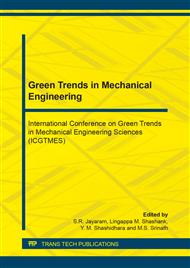p.52
p.58
p.64
p.70
p.76
p.83
p.90
p.96
p.102
Investigation on Effect of Cryogenic Temperature on Mechanical Behavior of Jute and Hemp Fibers Reinforced Polymer Composites
Abstract:
In past few decades, natural fibers which are viable and abundant in nature are the emerging trends in material science as reinforcement for polymer matrix materials and they are the commute for the non-biodegradable, non-renewable and high-density synthetic fibers. Plant-based fibers such as banana, hemp, kenaf, PALF, jute, and coir has been used as reinforcement in a polymer matrix for the applications in consumer goods, furniture’s, civil and automotive structures and low-cost housing structures. The natural fibers used in this study are Hemp and Jute fibers which are finding increasing in the composite material as reinforcements. The main objective of the current work is to examine the mechanical properties of hybrid fibers (hemp and jute) reinforced epoxy composites under room temperature and at cryogenic temperature. From this study, it is clear that tensile, flexural and impact properties of polymer composites are greatly influenced by cryogenic temperature and its properties vary with respect to the extent of cryogenic treatment. The specimens are immersed in liquid nitrogen for the duration of 15, 30, 45 and 60mins and later it is subjected for tensile, flexural and impact properties. The maximum tensile strength of 21.13MPa, flexural strength of 51.95MPa and Impact strength of 8.935kJ/m2 is obtained for an untreated specimen and its value start to decrease as curing time increases. At cryogenic temperature, the material comes harder and loses its ductile property and become brittle due differ in thermal expansion coefficient of matrix and fiber material
Info:
Periodical:
Pages:
76-82
Citation:
Online since:
November 2019
Authors:
Keywords:
Price:
Сopyright:
© 2019 Trans Tech Publications Ltd. All Rights Reserved
Share:
Citation:


